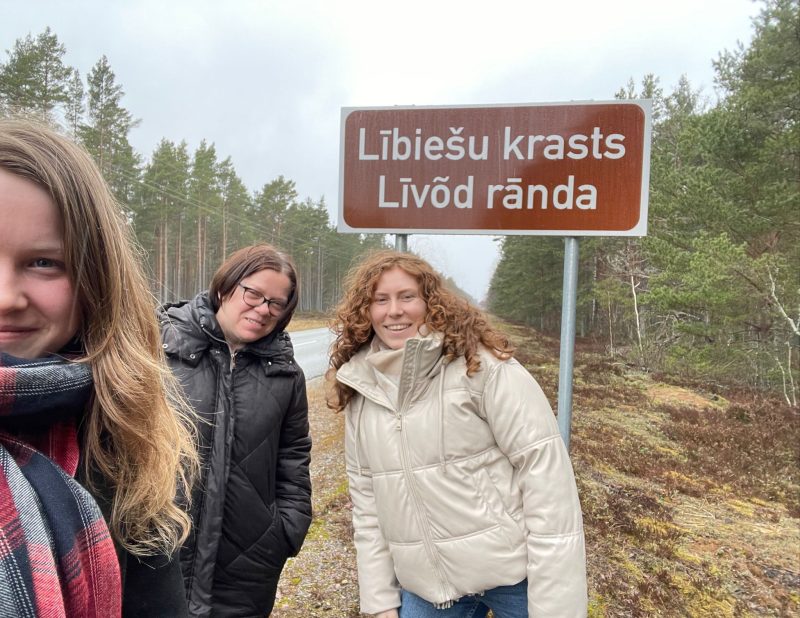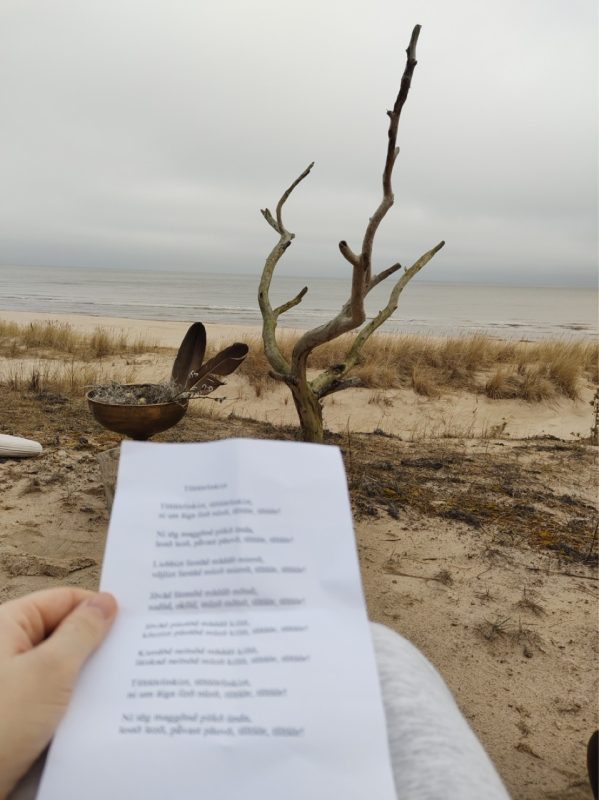Revitalizing Livonian through music: blog post
Revitalizing Livonian through Music – blog post by Bridget Moran-Nae
In this blog post, I would like to share my recent journey to Latvia. My name is Bridget Moran-Nae and I am a student in the Multilingualism MA at the University of Groningen in the Netherlands and an intern in the Re:voice project. I recently embarked on a research trip to Latvia to investigate the role of musical groups in the revitalization of the Livonian language.
With the following set of research questions in mind, I engaged with Livonian musicians and immersed myself in the rich cultural heritage of the Livonian community:
- What role do members of traditional music groups see for themselves as actors in the revitalization of Livonian?
- What are their attitudes towards Livonian and its revitalization?
- According to them, what impact do music and musical performance have on language revitalization?
- How do they envisage the future of the revitalization process?
The four musical ensembles whose members I intended to interview included Laula from Kolka, Līvlist from Riga, Rāndalist from Ventspils and Kāndla from Tārgale.
I arrived in Riga on the 8th of March, filled with a mix of excitement and nostalgia. Having visited Latvia regularly after my European Voluntary Service there in 2015-2016, I feel a deep connection to the country and its language. Riga, although transformed, still felt like a familiar place to me. I began my journey at the Livonian Institute by attending Dr. Karl Pajusalu’s lecture on Finnic languages and dialects in the Central Baltic area at the University of Latvia. This provided me with valuable insights and set the stage for my research.
During my initial weeks, I dedicated my time to conducting my literature review for my thesis and finalizing chapters for the Re:voice collective volume. In my free time, I made sure to embrace the cultural richness of Riga by participating in Latvian traditional folk dancing and attending a music party exclusively featuring Latvian music.

In celebration of Livonian heritage day, my colleagues Gunta, Anna and I took a weekend trip to the Livonian coast. This journey was the perfect opportunity to delve deeper into the traditions and customs of the Livonian community. We stayed by the sea in Pizā (Mikeltornis) and spent every morning and evening walking along the windy, deserted sandy beaches, with birch and pine tree forests behind us and the Baltic Sea in front of us. On the 23rd we drove to Ventspils, to attend Randalist’s 20th anniversary concert. It was a lovely experience, with Livonian filling the room, both through the songs and through the speeches of the singers and members of the Livonian community. The next morning, we woke up at 7am to be on the beach by 7.30 and awaken the birds. In earlier times, the Livonians believed that, rather than migrating south for the winter, the birds used to hibernate in hidden places. We sang the songs Tšītšōrlinkizt and tied ribbons in the colour of the Livonian flag (green, white and blue) to the trees, for the birds to find their way back. Later that day, we drove to Irē (Mazirbe) to awaken the birds once more, but this time with a larger congregation. The ceremony was led by Julgī Stalte, a Livonian musician. Once more, we sang to the birds and tied ribbons to trees, but we also presented an offering to the Sea Mother and shared bread, honey and red fruits. We washed our faces in amber dust and scared away evil spirits. In that moment, no matter what others might say, the Livonian language and Livonians culture felt, to me, very much alive.

On my return to Riga, I started my data collection, having been introduced to some members of the different musical groups during our trip to the coast. I was very grateful to Livlist for allowing me to join their rehearsals. They invited me to sing with them, and I had a wonderful time singing together with them in Livonian. I was given lyrics, musical sheets, and the text was translated to me by one of the members of the ensemble. Over the course of the following week, members of Livlist came by the Livonian Institute to share their experiences with me in my semi-structured interviews, sharing books and songs with me, both written and sung. I also carried out online interviews with two members of Laula, which unfortunately I was not able to interview in person due to lack of transportation. Whilst in Riga, I got in touch with members of Rāndalist in Ventspils and Kāndla in Tārgale to see when they might be able to chat with me.
Early in the morning on April 9th, I took the morning bus to Ventspils from Riga Central Bus Station. After a three hour ride, I arrived in the very windy city and my colleague Māra took me to the headquarters of the Livonian Union, a small room in a building just next to the market, where I would be carrying out my interviews. Over the next two days, I had the joy of chatting to some lovely ladies about their passion for singing in Livonian. I was also interviewed by Livones.net, the official Livonian website, and by Ventas Balss, the Ventspils newspaper, about my research. I can understand why they were quite curious about a Franco-English girl who speaks Latvian and is interested in Livonians.
I am currently writing this blog post from Café Windau, a small café in the old town of Ventspils. I have a few hours before my bus leaves to Riga and then another two days before my flight home. These five weeks have been a wonderful, enlightening academic and human experience. Many thanks to my colleagues at the Livonian Institute and the members of the Livonian ensembles who welcomed me and opened up to me.
My work on the role of musical ensembles in the revitalization of Livonian and my trip to Latvia were financed by the Livonian Institute’s project named “Continuity of Livonian: Understanding language transmission processes in a critically endangered contemporary indigenous community to develop process-driven instruments for preservation and revitalisation”, FLPP, Nr. lzp-2023/1-0264.






